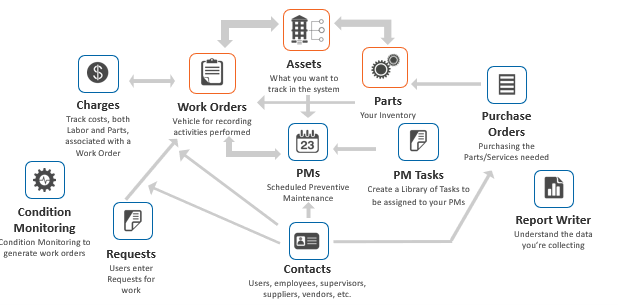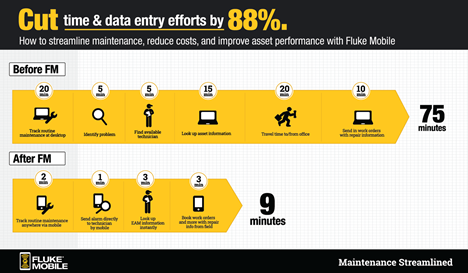In a March 2021 webinar, senior solutions engineer Michael Mills from Fluke Reliability describes what a successful CMMS implementation should accomplish and how to increase that value further.
The webinar, “Get more value from your CMMS (Part 1): best usage models for business impact and user adoption,” is available on demand.
Mills begins with an overview. computerized maintenance management system (CMMS), designed to improve the way maintenance and reliability professionals manage their operations, teams, inventory, compliance, and other activities.
By serving as a central location for teams to store all their asset and equipment related-data, CMMS systems help managers organize and schedule preventive and corrective maintenance, manage their labor, monitor wrench time, and track inventory, he notes. Figure 1 outlines the most common components of a CMMS system.

Figure 1. Core CMMS components
The more complete the asset maintenance history becomes, the more teams can track and analyze trends, using their dashboard of key performance indicators (KPIs) to identify process inefficiencies and potential asset failures.
Every implementation is unique, based on on-site conditions and objectives. But when a system is maximized, here’s how facilities should benefit from using their CMMS, according to Mills:
- Reduce unplanned downtime on equipment through records analysis and ease of access to digital records and documentation
- Increased visibility and transparency into daily operations: labor, expenses, actions, and schedule
- Increased worker productivity
- Elimination of manual processes
- Compliance with regulatory standards through documented processes and digital data capture
- A paperless work environment
- Extended asset lifespan
Sites not realizing these benefits may be better off “re-commissioning” the system and reconfiguring their usage model to align with management objectives. Reference this ”10 steps” approach to achieving fully leveraged CMMS implementations.
Once the organization effectively implements the core CMMS aspects, there is still more upside available. Here are Mills’ four recommendations for expanding CMMS usage models to support continuous improvement.
1. Warranty tracking
The first usage model that your team may not have considered is warranty tracking. Using the CMMS to improve documentation management leads to higher warranty recovery and up to 50% in lower costs.
Warranty is a legal right against defects in materials and quality. “Do not create an opportunity for the OEM to declare that the equipment was operated incorrectly – because then it becomes client versus OEM,” Mills says. “Using the CMMS to collect data proving that the equipment was operated correctly makes it much easier to claim warranty recovery.”
2. Resource utilization
Another approach is using CMMS data to focus on the value each technician brings and see what’s getting in their way. “Any inefficiencies you identify here become especially important to reduce when team members retire, more complex machines are added, the budget gets cut, or operational targets increase,” he says. He advises users to:
- Document procedures and practices that experienced team members do routinely and then have younger members try to replicate the process.
- Track how long it takes for specific tasks to be completed and look for opportunities to optimize.
- Use an asset criticality strategy to prioritize work orders and the aging backlog. Help technicians more systematically move from one area to the next.
- Extend asset criticality rankings to parts management. Assign criticality to each part, designate essential spares, and link equipment failure modes to the part number. Assess the lead time and costs to procure those parts and adjust which replacement parts are kept on-site based on their impact on downtime.
- Use the CMMS to evaluate overall parts usage and update inventory management to reflect actual usage. Excessive consumption patterns may reveal defects or other parts issues.
3. Mobility
Is it surprising that almost 30 years after the smartphone invention, many companies are still printing work orders? Not when you consider the longevity of certain equipment types and manufacturing platforms.
However, printed work orders are holding us back.
“Maintenance and reliability professionals need to access additional processes, capabilities, system integrations and other information, in addition to their work orders,” says Mills. “The difference between doing a punch list of PMs each month and prioritizing work through changing environments is an evolution in how we work.”
Shifting toolbelt thinking to include mobile devices gives technicians digital support at the point of contact with an asset. Mills advises asking: “What can I do with mobile, beyond just closing out this ticket, that will enable our teams and assets to be in a better place five, 10, 15 years down the line? For that matter, what can I do to ensure that the asset is in a better place for the next team member that works on it?”
Figure 2 demonstrates the advantages of switching to a mobile framework. Think about the time spent moving from one place or system to another. When physical processes get converted to clicks on a CMMS mobile interface, they become more consistent, accurate, and streamlined. Regulatory compliance also improves, such as documenting via mobile that safety procedures were followed for a PM.

Figure 2. Reducing data entry and travel time by converting to mobile CMMS usage
One customer Mills referenced converted to a mobile CMMS, eliminating 25 minutes per day in data entry per technician, and reducing calendar PM demand by 25%. This user’s maintenance team was able to troubleshoot issues 32% faster, leading to a 65% increase in critical assets’ production capacity.
4. Integrated condition monitoring
Smart assets and sensors are constantly supplying data to be leveraged by maintenance and reliability personnel. “You could be collecting all of the information in the world,” says Mills, “but if it’s not made into actionable data or if where it’s stored doesn’t drive an outcome, what good can it do for you?”
As Mills puts it, “Condition monitoring data, by itself, is incomplete. It doesn’t know when an asset was last serviced, or what actions were performed, or when maintenance is next due. It doesn’t know the asset’s history of failure, what parts are needed to complete specific jobs, and whether those parts are on hand or not.”
However, integrating specific, asset-health real-time condition monitoring data with CMMS asset management histories does create a more holistic picture for the maintenance and reliability team, enabling more informed decisions and more efficient use of resources.
In a previous Fluke Reliability survey, maintenance and reliability decision-makers reported:
- 84% did not have access to asset condition data in their CMMS
- Only 35% of maintenance teams had access to historical condition data when completing inspections
- 71% of organizations did not have an aggregated view of asset health
Every operation runs the risk of having siloed data if they don’t know where it should be stored or a path to connect it. In the webinar, Mills outlines how to integrate data from smart assets and sensors to the CMMS. This procedure alone is worth learning to add more value to your system.
Related articles:
Webinar: Get more value from your CMMS (Part 1): Best usage models for business impact and user adoption
Webinar: Get more value from your CMMS (Part 2): Integrations for improving machine health
10 steps to getting your CMMS implementation right (the first time)
